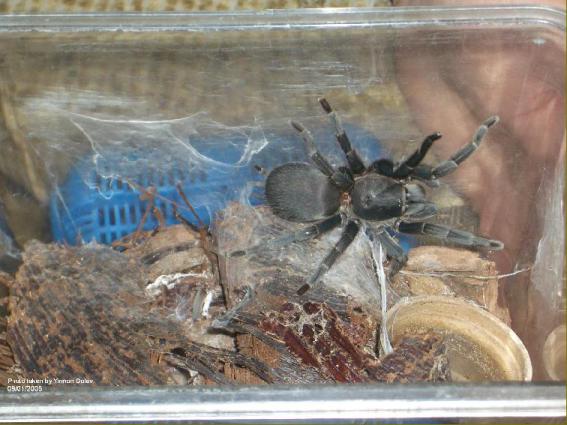
Observations of Chaetopelma olivaceum
Yinnon Dolev
Chaetopelma olivaceum is found throughout the middle east (including Cyprus) and the following observations are based on specimens collected in Israel.
Adult females commonly reach a 12cm legspan and are highly variable in colouration, several colour forms of C. olivaceum can be found throughout
Israel; specimens from the cooler northern regions (forest and plantation regions) are light brown contrasting with the mid and southern (desert regions) specimens which are grey to velvet black in
colouration, especially following a moult.
Opportunistic in it's habits, C.
olivaceum is often found in scrapes under stones but is not an extensive web builder and due to
extensive building in Israel that is invading the spiders natural habitat, it is often seen in first floor apartments and basements. Local people often mistake this species
for Latrodectus spp. (also present in the area). Most sightings are during the spring (April through to May) when the males are in search of females and during
the autumn (September through to November) when in search of winter housing. During these active months, specimens can be found in parks, nature trails and on roads, especially during the early hours
of the morning. There are reports of C.
olivaceum living in large colonies and I have seen this behaviour in the burial caves around
Jerusalem. In the Jordan Valley there have been reports of large communal groups living in dried up wells. Specimens found in the Jordan Valley are much smaller than specimens found in the central
regions of Israel (sub-species?).
Captive care: Average temperatures are suitable with relatively low humidity, a shallow water dish and a light misting once a week is sufficient. The cage shouldn't be allowed to dry out completely
and the water dish filled at all times. Growth rate in captivity will vary depending on conditions but on average, females will be sexually mature in three years (similar times are recorded for males
to reach their final moult). Being an opportunistic burrowing species, C.
olivaceum should be provided with a typical terrestrial set-up. It will construct its simple
retreat under any suitable object (cork bark slab or well secured rock, for example). Specimens will use silk to close the retreat entrance but won't web up the entire enclosure. A rather nervous
species, it is rather defensive so is not recommended for handling and caution is advise when doing cage maintenance as they can sometimes escape quickly once disturbed.
A cricket-based diet will suffice but this can be varied with the addition of cockroaches and mealworms etc. In their natural habitat they are known to take lizards (geckos and skinks
etc). C. olivaceum breed readily in captivity producing mobile eggsacs. On emergence, spiderlings will feed communally.
This is the only tarantula found in the holy-land, and it is not a protected species yet. Their numbers are decreasing due to extensive building and the destruction of its natural habitat (not
so true for the Jordan Valley). Some of the sub-species will probably adapt to co-existence with humans (the signs are all around), but others are facing a difficult
future.
